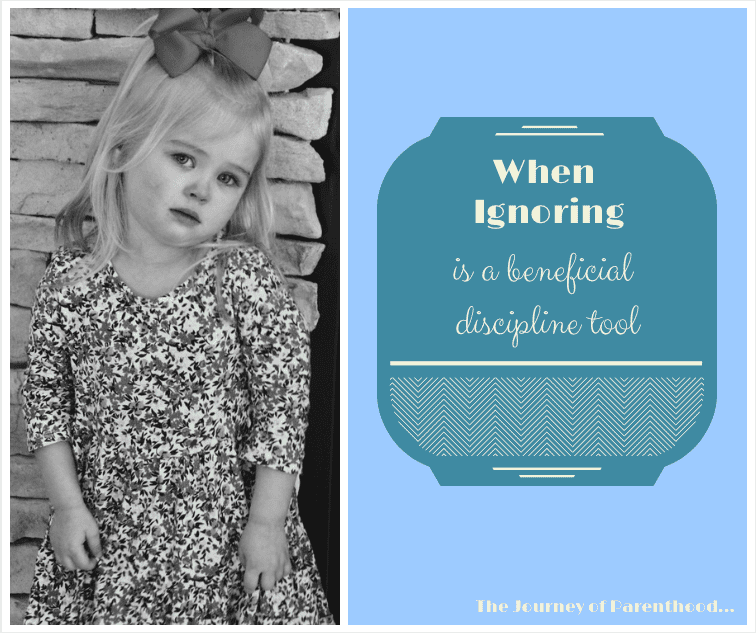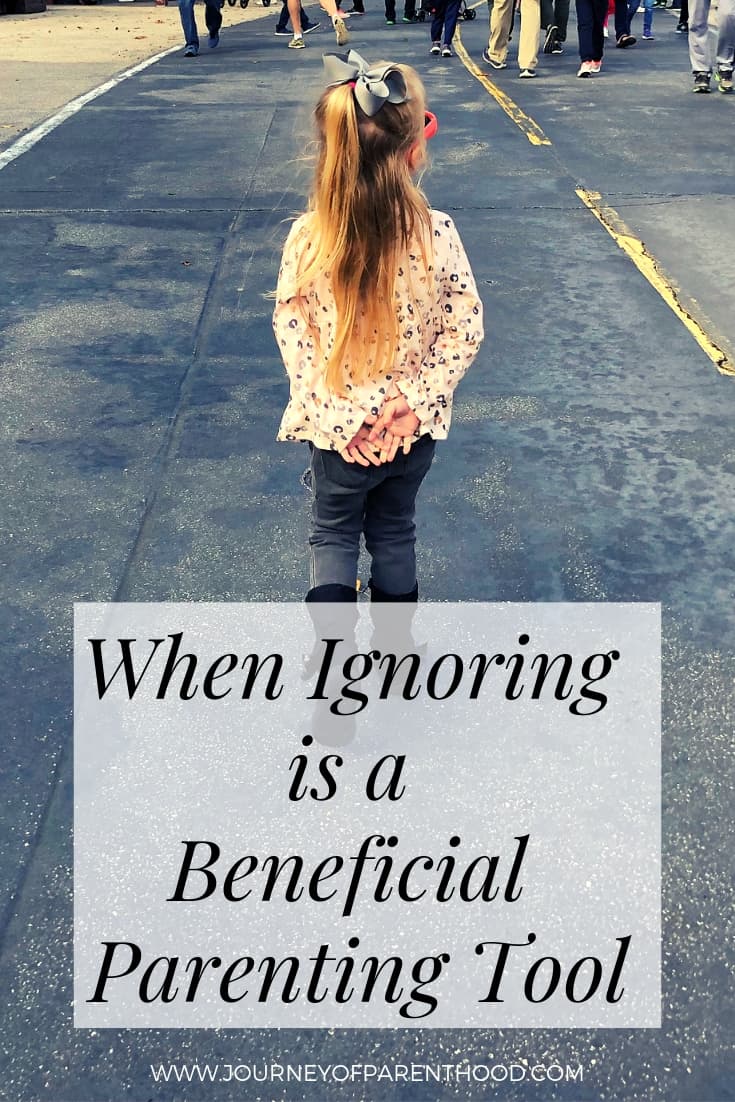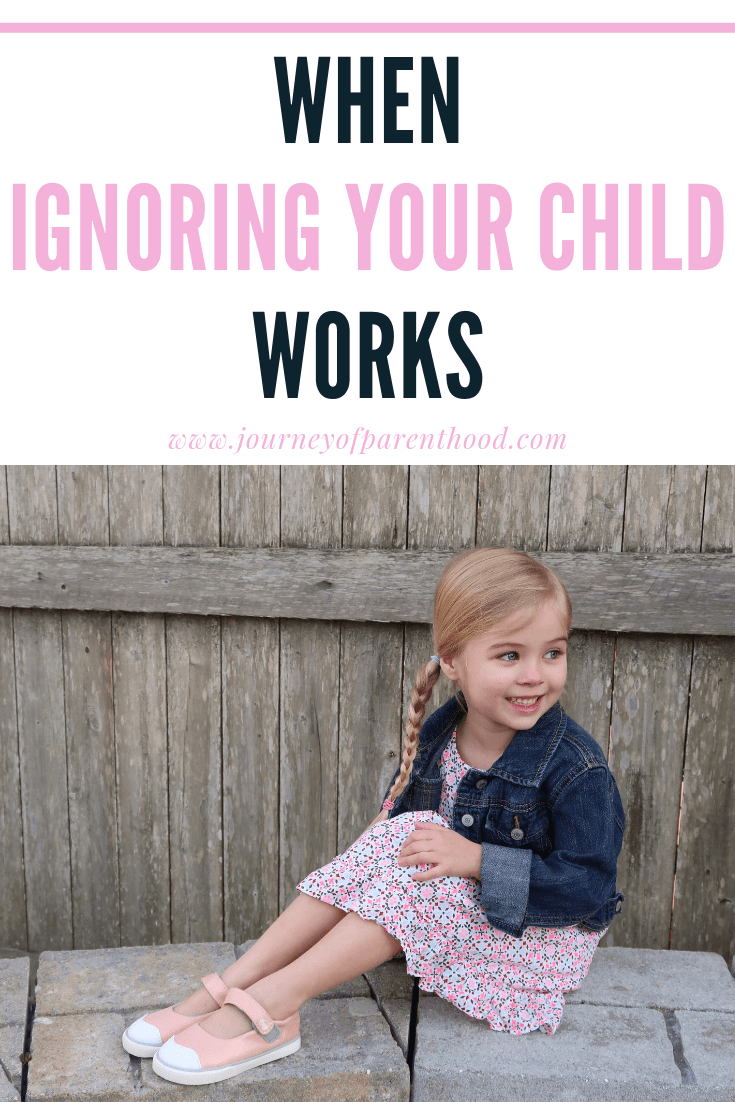When Ignoring is a Beneficial Discipline Tool.
It’s important as parents to have a parenting toolbox.
A toolbox filled with a variety of parenting tools to pull from when certain situations arise.
No two children are exactly alike.
Each child will respond differently to different discipline methods and a variety of circumstances will occur with children
One useful tool I have in my parenting toolbox for discipline is the tool of ignoring.
While it’s not my every day all day
And it’s not as easy of a discipline method as it may sound.
Ignoring a child while they are pitching a fit? Not easy.
Ignoring a child who insists they don’t want to meet Mickey Mouse after you’ve stood in line for an hour? Not easy.
My husband and I have both been working harder at ignoring when necessary and it really does work so we’re getting better at it 😉
An important thing to keep in mind when using ignoring as a discipline method is to make sure your child has a clear understanding of your expectations.
Make sure they understand the reasons behind why you are saying no to jumping on the bed or why they won’t be allowed dessert.
A big thing we are mindful of is having our children reply with a “yes ma’am” when we tell them something.
By requiring a “yes ma’am” response we know they heard us and understand us.
Therefore their decision making moving forward is on them and no excuses can be given somehow shifting

Here are 6 times when ignoring is a very effective parenting tool:
Toddler Tantrums
Toddlers are beginning to understand emotions.
They have
Toddler tantrums are a frequent occurrence.
I am a believer in allowing my children to express emotions but I’m also a believer in expressing them in the appropriate setting.
When my toddler pitches a fit, we put her on the couch (she actually now knows just to go to the couch when she’s pitching her fit and will ask to go there when she needs a good cry).
The couch is a safe place.
One where we can see her easily but also where she can feel that isolation.
We leave her be on the couch until she’s done with her fit and then she’s allowed to rejoin the family.
This is effective for toddlers but also for older children.
When there are struggles we will tell our older children to sit on the couch as well (separated if bickering is the problem at hand).
We all get upset at times and we need to be alone to process our thoughts and feelings.
Having that isolation on the couch is a way for our children to work through things on their own and calm down as well.
After a period of ignoring, we will talk with our older children if it’s something that needs to be talked through with them (sometimes they get so upset

Stubbornness
Our third child is our most stubborn.
She likes to do things on HER timeline and when SHE wants to do them.
Many times this isn’t possible.
We are on a set timeline and she has to do what we say when we say it.
But sometimes allowing her to work through her stubbornness is more effective than forcing her to work through it.
We explain our expectations and then ignore her.
Typically we like to use “two choices.”
For example, breakfast is on the table.
She says she doesn’t want to eat.
She is given two options: eat her breakfast before school or sit on the couch until we leave for school. We explain the options and then let her decide which one she wants to do.
Giving two choices shows our children that we are in charge but gives them the freedom to choose.
Typically choice a) is obeying Mommy and Daddy and choice b) is disobeying and having whatever appropriate disciplinary action we decide on.
Usually explaining things in this way allows our children to clearly recognize their options and most of the time (even with our
We have found it best to lay out the options and then ignore them.
We don’t add anything to the choices.
We don’t ask them what they think or what they are going to choose.
We just lay them out for them and then remove ourselves from the situation so they are able to choose.
This is very effective with a more stubborn child because it gives the illusion that they are in control of the outcome 🙂
Meal Struggles
I’m not a fan of meal struggles.
It’s so frustrating to prepare a meal for your family and then have children complain about it.
This is a common time where we have the complaining child leave the table and sit on the couch until they are ready to join the meal with a happy heart.
Many times our meals aren’t as a family. Breakfast and lunch are both usually at our bar in our kitchen so when there are meal struggles it’s easy for me to just ignore them.
Having multiple children comes in handy during meal time issues because as some of the kids enjoy the food, others are more likely to start eating as well.
I’ve found that if I just step back and don’t push my kids to eat that they are more likely to be more adventurous with their eating and are less likely to complain.
I give them their meals and then do my best to sit back and just allow them to eat (or not).
New Experiences
Trying new things can be intimidating for young children.
As parents, we get so excited to share the world with our children that we have expectations of what the experience will be like.
When it comes time to experience it, it can be so disappointing as a parent when your child doesn’t respond how you had anticipated they would.
We took our two-year-old to Disney for the first time this past November.
We LOVE Disney and were so excited to share this love with her for the first time.
She didn’t jump right in and instead was more reserved about things.
We’d wait in line to meet a character and it’d be our turn and she’d cry and say she didn’t want to meet them.
We quickly realized if we just ignored her that she was more likely to open up and have FUN.
At first, we were pushing her. “Come see Mickey!” “Oh my goodness MICKEY!”
Then we started to take a step back.
Rather than focusing on the child that was upset or disinterested, we instead put our energy into the kids that were excited and were having fun.
It turns out if you focus on the HAPPY kids then the grumpy ones will jump in for the fun and be happier too 🙂
It was such an effective strategy and her 2nd Disney trip went WAY smoother than her first due to this one simple trick!

Wanting Something
We don’t buy our kids random things.
If they are in a store and they point out something they want the answer is either “No” or “You can save your money” or “You can put it on your Birthday/Christmas Wishlist.”
I can’t remember the last time I purchased something on a whim for my children at a store when they asked. Maybe never?
Our older kids typically don’t even ask and when they do and I say no they say “I knew you’d say no.”
But younger kids can struggle with seeing something they want and not being allowed to have it right then.
Delayed gratification takes time to learn and understand and little ones can’t fully grasp it.
I have found by giving a clear and firm “No” and then moving on works well.
Typically we are in public when this happens and tears may follow.
Heck
I know SO many people say if your child pitches a fit in public to leave your buggy and walk out of the store. But guys. C’mon.
If I’m at the store with my kid then it’s clearly a must-run errand otherwise I’d have waited and gone solo when my husband was home and able to keep the kids with him.
I’m not about to abandon all my stuff just to handle a child who is having a meltdown. No way!
I feel like if I leave the store when a fit occurs then the child “wins.” They are given the control to dictate my actions and that’s not how things work in our home.
When public fits happen (most typically it’s a toddler wanting something they aren’t allowed to have OR wanting to DO something they aren’t allowed to do) I keep on trucking.
I will ignore the child and get what I need to get done finished.
Yes people look. Yes, I’m sure they judge.
And sometimes well-meaning people can mess up the lesson I’m trying to teach (Just yesterday at Publix. My daughter dropped her sucker on the ground b/c she was upset. She cried. I ignored.
But an employee came and gave her a balloon then a kind stranger bought her a new sucker. Ha!). But USUALLY, if I ignore the public fit, it goes away.

Bedtime Struggles
I am a firm believer when it comes to bedtime that you can lead a horse to water but you can’t make him drink.
Even if you set up your child for the perfect sleep environment, he or she just may not sleep.
And that’s okay!
I try not to stress over if my kids are actually asleep or not and just focus on if they are being quiet and staying in the bed.
As long as they are quiet and in bed then I’m golden!
Sometimes bedtime issues call for going in and comforting or offering medicine if sick or seeing what’s going on.
But at a certain age ignoring really is what works best most of the time if there are sleep disturbances.
One of my children wakes every single night right at 11 pm.
When she was an infant this stressed me out.
I tried everything to get her to stay sleeping
What I eventually realized was that this was just part of her natural sleep cycle.
She wakes at 11, cries out for 2 min or less, then BAM! is back to sleep solid till morning.
I learned to let her do her thing and that it was better not to interfere.
Ignoring is not a parenting tool we utilize every time disciplinary action is needed. And often ignoring is a time period situation.
For example…when children seem frustrated rather than jumping in to help it’s best to “ignore” them for a few minutes.
Give them a chance to figure things out on their own before coming in and taking over the task or jumping in and micromanaging how they do things.
Often we need to consider ignoring as a pause.
A chance for us to catch our breath and truly think through what the best path is to handle the specific situation.
Ignoring also allows our children to work through their thoughts, feelings, and emotions.
It’s a way to separate ourselves from the moment at hand and be able to come back to it with a more clear perspective.
Do you use ignoring as a tool in your parenting toolbox? What other ways have you found it to be effective?
Sometimes…bribery is also a beneficial tool and you can read how here!
Be sure to visit my Facebook Page! I share all of my blog posts there as well as many other items of interest for fellow mamas.
You can also follow me on Instagram where I’m pretty much obsessed with Instagram Stories!
- 10th Birthday Message For My Daughter Love Mom {Tess’s 10th Birthday Letter} - June 12, 2025
- Tips to Maintain Structure While Traveling with Kids - May 22, 2025
- A Letter to my Son on His 16th Birthday From Mom (Kye’s Bday Letter) - April 30, 2025






